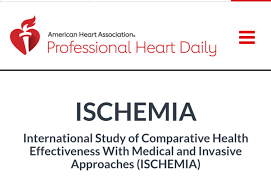You wanna know more of this fantastic, game-changer study? Sure!
Let’s break down this abstract into simpler terms.
We’ll walk the talk about two important studies in heart health and what they’re trying to find out.

This is a bit like a detective story in the world of medicine, where doctors are trying to figure out the best way to treat a tricky condition called Chronic Coronary Syndrome (CCS).
Who are the Antonio & Bassanio?
ISCHEMIA & ISCHEMIA-CKD Trials!
First, let’s meet our main characters: the ISCHEMIA and ISCHEMIA-CKD trials. These are big research studies involving people who have chronic coronary disease, CAD, which means they have long-term problems with the blood vessels that supply their heart.

These patients also had moderate to severe ischemia, which is a fancy way of saying their heart muscles were not getting enough blood and oxygen, especially during stress, like exercise. The ISCHEMIA-CKD trial included a special group of patients who, in addition to having heart problems, also had advanced chronic kidney disease (CKD), making their treatment more complicated.

What is the Plot?
Invasive vs. Conservative Strategies

The plot of our story revolves around two different ways to treat these heart problems: the “invasive” strategy and the “conservative” strategy.
- Invasive Strategy: This is like taking a direct approach. Doctors use tools to look inside the blood vessels of the heart (this is called angiography) and do procedures to open up any blockages (revascularization). It’s a bit like calling in a team of plumbers to directly fix the pipes of a house.
- Conservative Strategy: This is more like a wait-and-see approach, where doctors primarily use medications to manage the condition. They only do the plumbing work (angiography and other procedures) if the medications don’t help enough.

Encounter the Twist:
Unexpected Findings
The researchers were trying to find out which strategy was better for patients in the long run. But here’s the twist: they didn’t find a clear winner.
Both strategies had their pros and cons. For instance, patients who went the invasive route had fewer spontaneous heart attacks down the line, but they had more heart attacks right after the procedure (these are called peri-procedural MIs).

On the other hand, there wasn’t a big difference in overall death rates between the two groups.
The Sequelae?
ISCHEMIA-EXTEND & ISCHEMIA-CKD EXTEND
Because the results were a bit like a cliffhanger, the researchers decided to do a follow-up, kind of like a sequel in a movie series.
These follow-ups are called ISCHEMIA-EXTEND and ISCHEMIA-CKD EXTEND. They’re like long-term observational studies where the researchers keep an eye on the surviving participants from the original trials.
They want to see how they do over a really long time (like 9-10 years).

What is the Goal:
Understanding Long-Term Effects
The big question these sequels are trying to answer is: over the long haul, which strategy is actually better for the patients? They’re looking at all kinds of death rates – like deaths from heart problems (cardiovascular mortality) and deaths from other causes (non-cardiovascular mortality) – to see if there are any significant differences between the two treatment approaches.

The Method: Bayesian Survival Modeling
To figure this out, they’re using a cool math technique called Bayesian survival modeling. It’s like having a super smart detective that can look at all the clues and make really educated guesses about what’s likely to happen in the future.
And the winner is…
Awaiting the Results!!
We’re still waiting for the big reveal – the final results of these follow-up studies. Whatever they find out is going to be super important.
It will help doctors, patients, and everyone in the healthcare policy world make better decisions about how to treat chronic coronary disease, especially in patients who also have kidney problems.

Why It Matters!!
This research is like a puzzle that doctors are trying to solve to help people with heart and kidney problems live longer, healthier lives.
By figuring out the best treatment strategies, they can provide better care and guidance for patients around the world.

In Simple Terms
Imagine your heart as a garden that needs a regular water supply. The blood vessels are like garden hoses.
In some people, these hoses are kinked or blocked (that’s the coronary disease).
Now, the doctors are like gardeners deciding the best way to fix this problem.

Do they go in and directly fix the hoses, or do they try other methods like adjusting the water pressure (with medicines) and only fix the hoses if absolutely necessary?
These studies are trying to find out which method keeps the garden (your heart) healthier in the long run!

The Big Picture
It’s all about finding the best way to help patients with heart and kidney issues. The more they know, the better doctors can plan treatments, and the more lives can be saved or improved. These are very important ground-breaking studies, which ever human being awaits to unfold. The sooner, the better. (See the scholarly article)